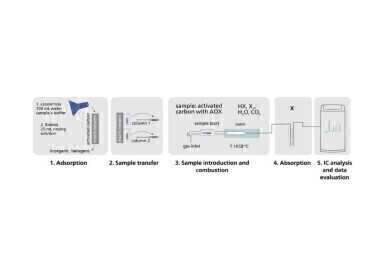Chromatography
Analysing Halogenated Organic Compounds with CIC according to DIN 38409-59
Feb 06 2023
Have you ever wondered what makes your clothing water repellent or your pans non-stick properties? It could be the use of per and polyfluorinated alkyl substances (PFASs) to coat these materials. This article will briefly explain how PFASs have been utilised and how we can now better analyse and monitor these substances with combustion ion chromatography (CIC) according to the new DIN 38409-59 standard.
PFASs are a classification of thousands of organic molecules in which all the hydrogen atoms on at least one methyl or methylene carbon atom are replaced by fluorine. Their unique chemical and physical properties, including their water and oil repelling quality, make them ideal for industrial usage. The strong C-F bond makes these substances highly stable causing them to resist degradation, hence earning the nickname ‘forever chemicals.’ Research into the adverse health effects of some of these substances is increasing, causing restrictions to be put on their usage and growing public interest in monitoring these compounds and their degradation products.
The new DIN 38409-59 (Determination of adsorbable organically bound fluorine, chlorine, bromine, and iodine (AOF, AOCl, AOBr, AOI) by means of combustion and subsequent ion chromatography measurement) fills the gaps left by DIN ISO 9562 and EPA Method 1650 by enabling the determination of AOF, AOCl, AOBr, and AOI as individual fractions and as the sum parameter CIC-AOX(Cl). Adsorbable organic fluorine (AOF) is a sum parameter for non-targeted screening of per- and polyfluorinated alkyl substances (PFASs) in waters.
- Measuring AOF, with CIC, is simpler and faster than targeted analysis methods such as LC-MS/MS.
- Measuring AOF is more sensitive than total fluorine (TF) determination. TF includes both organic and all inorganic fluorine, AOF measures just the total organic fluorine.
In, this way the measurement of AOF in water samples as an initial screening step gives a fast overview of the actual amount of organic fluorinated compounds present.
This would then be followed by targeted analyses (LC-MS/MS) of individual PFASs if indicated by higher AOF concentrations. Each step of the new method is illustrated in Figure 1.
Watch the video to learn more about using Metrohm CIC to analyse adsorbable organic halogens (AOX and AOF) in water samples faster and more efficiently according to DIN 38409-59.
Digital Edition
ILM 49.5 July
July 2024
Chromatography Articles - Understanding PFAS: Analysis and Implications Mass Spectrometry & Spectroscopy Articles - MS detection of Alzheimer’s blood-based biomarkers LIMS - Essent...
View all digital editions
Events
Jul 28 2024 San Diego, CA USA
Jul 30 2024 Jakarta, Indonesia
Jul 31 2024 Chengdu, China
ACS National Meeting - Fall 2024
Aug 18 2024 Denver, CO, USA
Aug 25 2024 Copenhagen, Denmark




24_06.jpg)













